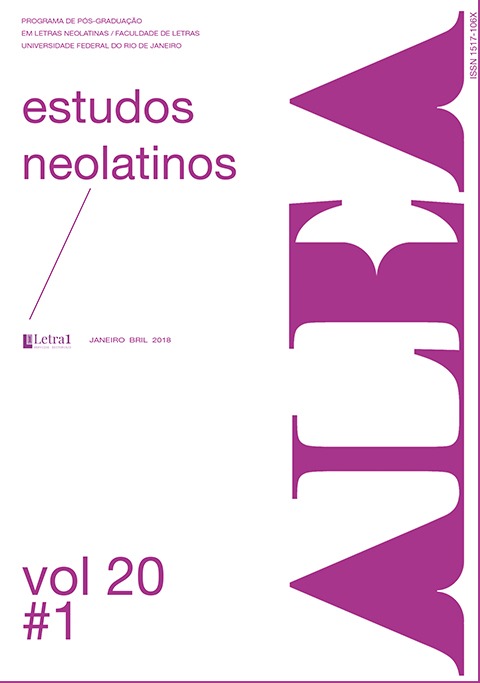El hombre de Montserrat: writings on violence in the latin american crime fiction
DOI:
https://doi.org/10.1590/1517-106x/2018201142160Abstract
This article adresses the novel El hombre de Montserrat, written by the Guatemalan writer Dante Liano and recognized within the genre of crime fiction, as a precursory model for a narrative that established a way of rewriting the history of violence in Central American countries in both fictional and theoretical terms. Dante Liano's successful reception has turned the novel into a reference of the Central American literature of the nineties. ftis is due to the fact that his narrative is replete with mechanisms that were seen in the best works of the previous Latin American narrative, far from the great discourses, by a displaying genre hybridization, a parodic transgression or lexical localism.
Downloads
References
ACEITUNO, Luis. “Dante Liano: memorias de la guerra sucia”. Liano, Dante. El hombre de Montserrat. Guatemala: Editorial Piedra Santa, 2005.
ACEVEDO LEAL, Anabella. “La estética de la violencia: Deconstrucciones de una identidad fragmentada”. Temas centrales. Primer simposio centroamericano de prácticas artísticas y posibilidades curatoriales contemporáneas. San José: TEOR/ ética-Gate Foundation, 2000: 98-108.
BARRIENTOS, Dante. “Les jeux de mise en abyme dans El hombre de Montserrat (1996) de Dante Liano”. Cahiers d'etudes romances, 9, 2003: 133-146.
COELLO, Emiliano. “Variantes del género negro en la novela centroamericana actual (1994-2006)”, Itsmo, 17, 2008. Recuperado de http://istmo.denison.edu/ n17/proyectos/coello.html
CORTEZ, Beatriz. “Estética del cinismo: la ficción centroamericana de posguerra”.
V Congreso Centroamericano de Historia, San Salvador, 2000.
Grinberg, Valeria. “La est/ética de la guerra en El hombre de Montserrat de Dante Liano”. Centroamericana, 17, 2009: 21-34.
JASTRZĘBSKA, Adriana Sara. “Fuera del tiempo y del mundo: literaturas centroamericanas actuales frente a su historia reciente: Horacio Castellanos Moya”. Romanica Silesiana, 6, 2011: 321-341.
JUAN PENALVA, Joaquín. “De cómo el roman fusion llego a serlo: prehistoria literária de uma nueva historia narrativa”. Anales de literatura española. 17, 2004: 89-106.
LAORDEN, María Teresa. “Ni Marlowe ni Sherlock. Violencia y novela policíaca en tres ejemplos centroamericanos”. Philobiblion, 1, 2015: 153-164.
LIANO, Dante. “La narrativa de la Violencia”. Visión crítica de la literatura guatemalteca. Guatemala: Ed. Universitaria, 1997: 259-271.
LIANO, Dante. El hombre de Montserrat. Barcelona: Roca editorial, 2005.
MACKENBACH, Werner y Ortiz, Alexandra. “Deformaciones: violencia y narrativa en Centroamérica”. Iberoamericana, VIII, 32, 2008: 81-97.
MARTÍN, Alex y SÁNCHEZ, Javier. “Una mirada al neopolicial latinoamericano: Mempo Giardinelli, Leonardo Padura y Paco Ignacio Taibo II”. Anales de Literatura Hispanoamericana, 36, 2007: 49-58.
MEJÍA, José. “La metáfora como buena conductora de mundo en El hombre de Montserrat”. Centroamericana, 12, 2007: 43-65.
NOGUEROL, Francisca. “Neopolicial latinoamericano: el triunfo del asesino”. Ciberletras: Revista de crítica literaria y de cultura, 15, 2006. Recuperado de http://www.lehman.edu/faculty/guinazu/ciberletras/v15/noguerol.html
ORTIZ, Alexandra. “Literatura y violencia: para una lectura de Horacio Castellanos Moya”. Centroamericana, 12, 2007a: 85-99.
ORTIZ, Alexandra. “Las batallas de la memoria: La novela centroamericana como lugar de sobrevivencia”. Revista Estudios Universidad de Costa Rica, 20, 2007b: 285-293.
PACHECO, José Emilio. Tarde o temprano. México: FCE, 2000. RAMÍREZ, Alfredo, Marínez, Lino, Hurtado, Saúl y Melchor, Guadalupe.
“Ética y guerra en relatos sobre violencia política en Guatemala (1960-
. Cuadernos de Intercambio sobre Centroamérica y el Caribe, 14, 1, 2007: 23-49.
SEOANE, Mercedes Elena. “El hombre de Montserrat de Dante Liano”. O Itsmo, 25/09/2014. Recuperado de https://oistmo.com/2014/09/25/analise- en-el-cruce-entre-el-policial-y-la-denuncia-el-hombre-de-montserrat- de-dante-liano/
SKLODOWSKA, Elzibeta. La parodia en la nueva novela hispanoamericana (1960-1985). Amsterdam: John Benjamins Publisihing, 1991.
TODOROV, Tzevan. “Tipolología de la novela policial”. Link, Daniel (comp.). El juego de los cautos. La literatura policial: de Poe al caso Giubileo. Buenos Aires: La Marca Editora, 1992: 46-51.
TOLEDO, Aída. “El hombre de Montserrat de Dante Liano: trasgresión paródica de la fórmula de la novela negra”. Vocación de herejes: Reflexiones sobre la literatura guatemalteca contemporánea. Guatemala: Editorial Cultura-Academia Editores, 2002: 90-103.
VALERO, Eva. Lima en la tradición literaria de Perú. De la leyenda urbana a la disolución del mito, Lleida: Universitat de Lleida, 2000.
Downloads
Published
Issue
Section
License
THE AUTHOR/S confirm/s his, her or their participation in all stages of work preparation: 1) Conception, project, bibliographical research, analysis and interpretation of data; 2) Writing and reviewing the manuscript; 3) Approval of the final version of the manuscript for publication; 4) Responsibility for all aspects of the work and guarantee for the accuracy and integrity of any part of the work. The submission of works implies the immediate cession, without onus, by all authors, of publication rights to the journal Alea, licensed under CC BY (https://creativecommons.org/licenses/by/4.0/). The authors are fully responsible for the content of the article and continue to hold all copyrights for subsequent publications of it, and should, if possible, include the reference to the first publication in the journal. Alea does not commit to returning received contributions. Authors of articles, reviews or translations will receive a copy of the journal.

